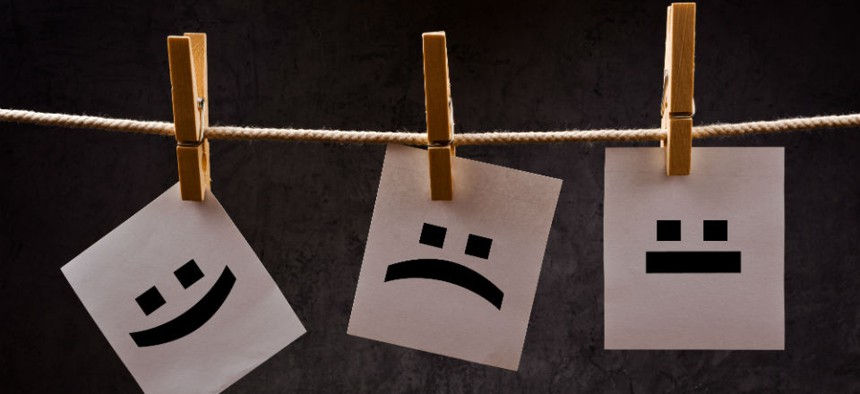The Real Roots of Midlife Crisis
What a growing body of research reveals about the biology of human happiness.
This summer, a friend called in a state of unhappy perplexity. At age 47, after years of struggling to find security in academia, he had received tenure. Instead of feeling satisfied, however, he felt trapped. He fantasized about escape. His reaction had taken him by surprise. It made no sense. Was there something wrong with him? I gave him the best answer I know. I told him about the U-curve.
Not everyone goes through the U-curve. But many people do, and I did. In my 40s, I experienced a lot of success, objectively speaking. I was in a stable and happy relationship; I was healthy; I was financially secure, with a good career and marvelous colleagues; I published a book, wrote for top outlets, won a big journalism prize. If you had described my own career to me as someone else’s, or for that matter if you had offered it to me when I was just out of college, I would have said, “Wow, I want that!” Yet morning after morning (mornings were the worst), I would wake up feeling disappointed, my head buzzing with obsessive thoughts about my failures. I had accomplished too little professionally, had let life pass me by, needed some nameless kind of change or escape.
My dissatisfaction was whiny and irrational, as I well knew, so I kept it to myself. When I thought about it—which I did, a lot—I rejected the term midlife crisis, because I was holding a steady course and never in fact experienced a crisis: more like a constant drizzle of disappointment. What annoyed me most of all, much more than the disappointment itself, was that I felt ungrateful, the last thing in the world I was entitled to be. Hopeful that rationality might prevail, I would count my blessings, quite literally—making lists mentally, and sometimes also on paper of all that I had to be thankful for. Reasoning with myself might help for a little while, but then the disappointment would return. As the weeks turned into months, and then into years, my image of myself began to change. I had always thought of myself as a basically happy person, but now I seemed to be someone who dwelt on discontents, real or imaginary. I supposed I would have to reconcile myself to being a malcontent.
As I moved into my early 50s, I hit some real setbacks. Both of my parents died, one of them after suffering a terrible illness while I watched helplessly. My job disappeared when the magazine I worked for was restructured. An entrepreneurial effort—to create a new online marketplace that would match journalists who had story ideas with editors looking for them—ran into problems. My shoulders, elbows, and knees all started aching. And yet the fog of disappointment and self-censure began to lift, at first almost imperceptibly, then more distinctly. By now, at 54, I feel as if I have emerged from a passage through something. But what?
Long ago, when I was 30 and he was 66, the late Donald Richie, the greatest writer I have known, told me: “Midlife crisis begins sometime in your 40s, when you look at your life and think, Is this all? And it ends about 10 years later, when you look at your life again and think, Actually, this is pretty good.” In my 50s, thinking back, his words strike me as exactly right. To no one’s surprise as much as my own, I have begun to feel again the sense of adventure that I recall from my 20s and 30s. I wake up thinking about the day ahead rather than the five decades past. Gratitude has returned.
I was about 50 when I discovered the U-curve and began poking through the growing research on it. What I wish I had known in my 40s (or, even better, in my late 30s) is that happiness may be affected by age, and the hard part in middle age, whether you call it a midlife crisis or something else, is for many people a transition to something much better—something, there is reason to hope, like wisdom. I wish someone had told me what I was able to tell my worried friend: nothing was wrong with him, and he wasn’t alone.
In the 1970s, an economist named Richard Easterlin, then at the University of Pennsylvania, learned of surveys gauging people’s happiness in countries around the world. Intrigued, he set about amassing and analyzing the data, in the process discovering what came to be known as the Easterlin paradox: beyond a certain point, countries don’t get happier as they get richer. Today he is at the University of Southern California and is celebrated as the founder of a new branch of economics, focused on human well-being. At the time, though, looking at something as subjective as happiness seemed eccentric to mainstream economists. His findings, Easterlin says, were for many years regarded as a curiosity, more a subject for cocktail conversation than for serious research.
A generation later, in the 1990s, happiness economics resurfaced. This time a cluster of labor economists, among them David Blanchflower of Dartmouth and Andrew Oswald of the University of Warwick, got interested in the relationship between work and happiness. That led them to international surveys of life satisfaction and the discovery, quite unexpected, of a recurrent pattern in countries around the world. “Whatever sets of data you looked at,” Blanchflower told me in a recent interview, “you got the same things”: life satisfaction would decline with age for the first couple of decades of adulthood, bottom out somewhere in the 40s or early 50s, and then, until the very last years, increase with age, often (though not always) reaching a higher level than in young adulthood. The pattern came to be known as the happiness U-curve
(Image via igor.stevanovic/Shutterstock.com)



